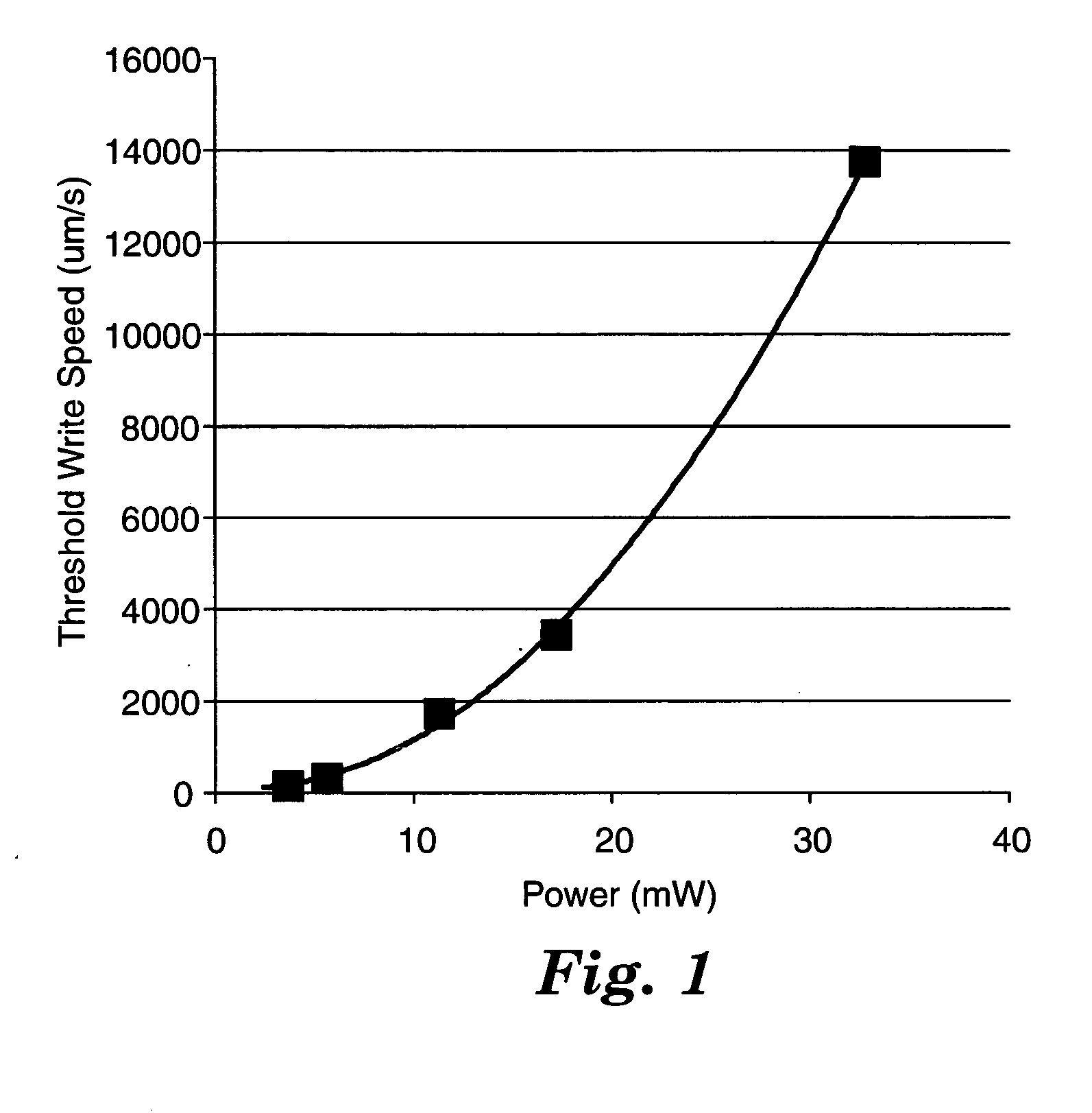Multiphoton photosensitization system
a photoensitization system and photoensitization technology, applied in the field of multiphoton methods, can solve the problems of high laser power, slow writing speed, limited work, etc., and achieve the effects of increasing sensitivity, enhancing multiphoton photosensitivity, and efficiently forming reaction-initiating species
- Summary
- Abstract
- Description
- Claims
- Application Information
AI Technical Summary
Benefits of technology
Problems solved by technology
Method used
Image
Examples
examples
Objects and advantages of this invention are further illustrated by the following examples, but the particular materials and amounts thereof recited in these examples, as well as other conditions and details, should not be construed to unduly limit this invention.
Glossary
PSAN—poly(styrene-co-acrylonitrile) with weight average molecular weight of about 165,000, and 25 weight % acrylonitrile, available from Aldrich, Milwaukee, Wis.
SR-9008—alkoxylated trifunctional acrylate ester, available from Sartomer Co., Exton, Pa.
SR-368—tris (2-hydroxyethyl) isocyanurate triacrylate, available from Sartomer Co., Exton, Pa.
DPI PF6—can be made essentially as described in column 4 of U.S. Pat. No. 4,394,403 (Smith), using silver hexafluorophosphate.
EDMAB—ethyl 4-dimethylaminobenzoate, available from Aldrich, Milwaukee, Wis.
TMSPMA—3-(trimethoxysilyl)propyl methacrylate, available from Aldrich, Milwaukee, Wis.
DIDMA—N-(2,6-diisopropyl)-N,N-dimethylaniline, available from Aldrich, Milwa...
examples 1-2
A stock solution was prepared by adding 30 g PSAN to 120 g dioxane, and mixing overnight on a roller. A second solution was prepared by adding 1 g of MPS 1 to 35 g SR-9008, then heating and stirring to partially dissolve the photosensitizer. The second solution was added to the stock solution and allowed to mix overnight on a roller. To this solution was added 35 g SR-368 and the solution allowed to mix overnight on a roller, providing masterbatch A. In two separate vials, 11 g of masterbatch A was placed. 0.1 g DPI PF6 was dissolved in 1 ml of acetonitrile and added to the first vial containing 11 g of masterbatch A and the resulting solution mixed by agitation and then used in Example 1. 0.1 g DPI PF6 and 0.1 g EDMAB were dissolved in 1 ml of acetonitrile and added to the second vial containing 11 g masterbatch A, and the resulting solution used in Example 2.
Two milliliters of each of the two solutions prepared above were filtered through a 0.45 μm syringe filter and coated wit...
example 7
Coated films were prepared and patterned essentially as in Example 6 at 4, 6, 11, 17 and 30 mW average laser power, and threshold writing speeds were determined essentially as in Examples 3-6. The threshold writing speed scaled quadratically with the average power, as shown in FIG. 1, consistent with a two-photon induced photopolymerization.
PUM
| Property | Measurement | Unit |
|---|---|---|
| electronic excited state | aaaaa | aaaaa |
| solubility | aaaaa | aaaaa |
| two-photon absorption cross-section | aaaaa | aaaaa |
Abstract
Description
Claims
Application Information
 Login to View More
Login to View More - R&D
- Intellectual Property
- Life Sciences
- Materials
- Tech Scout
- Unparalleled Data Quality
- Higher Quality Content
- 60% Fewer Hallucinations
Browse by: Latest US Patents, China's latest patents, Technical Efficacy Thesaurus, Application Domain, Technology Topic, Popular Technical Reports.
© 2025 PatSnap. All rights reserved.Legal|Privacy policy|Modern Slavery Act Transparency Statement|Sitemap|About US| Contact US: help@patsnap.com



